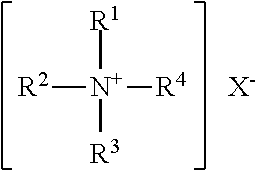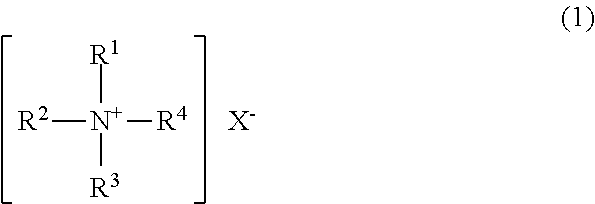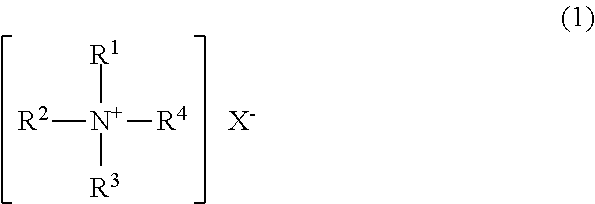Method for inkjet textile printing
a textile printing and inkjet technology, applied in textiles, dyeing processes, coatings, etc., can solve the problems of pigment ink, pigment ink precipitation and flocculation, and the ink pigment is prone to precipitation and flocculation, so as to reduce fastness properties, prevent bleeding, and high density
- Summary
- Abstract
- Description
- Claims
- Application Information
AI Technical Summary
Benefits of technology
Problems solved by technology
Method used
Image
Examples
example 1
Pretreatment Agent 1
[0188]5 parts of didecyldimethylammonium chloride, 5 parts of Fixer N (trade name for a block isocyanate compound manufactured by Matsui Shikiso Chemical Co., Ltd.), and 90 parts of water were mixed with stirring to yield a pretreatment agent 1.
[0189]
[0190]Cotton broadcloth, polyester crepe de chine, and T / C broadcloth were each padded with the pretreatment agent 1 at a wringing rate of 60% and then dried at 60° C. for 10 minutes to yield respective pretreated cloths 1.
[0191]
[0192]One stirrer, one thermometer, and three dropping funnel were set to a 1-liter glass flask, 442 parts of water and 15 parts of AQUARON KH-10 (trade name for a reactive surfactant manufactured by Dai-ichi Kogyo Seiyaku Co., Ltd.) were placed in the flask, the atmosphere was replaced with nitrogen with stirring, and the flask was heated to 60° C.
[0193]Subsequently, various materials were added drop by drop to the flask:
a mixture of 100 parts of butyl acrylate, 20 parts of ethyl acrylate, 3...
example 2
Pretreatment Agent 2
[0212]5 parts of distearyldimethylammonium chloride, 5 parts of Fixer N, and 90 parts of water were mixed with stirring to yield a pretreatment agent 2.
[0213]
[0214]Cotton broadcloth, polyester crepe de chine, and T / C broadcloth were each padded with the pretreatment agent 2 and then dried at 60° C. for 10 minutes in the same manner as Example 1 to yield respective pretreated cloths 2.
[0215]
[0216]Starting materials were treated in the same manner as the obtainment of a water-soluble dispersing agent 1 in Example 1 except that the monomers in the first dropping funnel were replaced with 140 parts of butyl acrylate, 20 parts of ethyl acrylate, 30 parts of 2-ethylhexyl acrylate, 80 parts of methacrylic acid, 10 parts of acrylic acid, and 20 parts of hydroxyethyl acrylate, to yield a water-soluble dispersing agent 2 having a pH of 8.2 and a molecular weight of 7,000.
[0217]
[0218]20 parts of pigment, 28 parts of water-soluble dispersing agent 2, 48.5 parts of water, 20 ...
example 3
Pretreatment Agent 3
[0233]5 parts of didecyldimethylammonium chloride, 5 parts of AQB-102 (trade name for a block isocyanate compound manufactured by Nippon Polyurethane Industry Co., Ltd.), and 90 parts of water were mixed with stirring to yield a pretreatment agent 3.
[0234]
[0235]Cotton broadcloth, polyester crepe de chine, and T / C broadcloth were each padded with the pretreatment agent 3 and then dried at 60° C. for 10 minutes in the same manner as Example 1 to yield respective pretreated cloths 3.
[0236]
[0237]20 parts of the pigment dispersion 1 of Example 1, 18 parts of glycerin, 20 parts of PERMARIN UA-300, 28 parts of water, and 9 parts of AQB-102 were mixed with stirring, 5 parts of water or ethylene glycol was added to obtain a viscosity of 5 mPa·s at 20° C. and a surface tension of 32 mN / m, whereby an aqueous pigment ink 3 was obtained.
[0238]Aqueous pigment inks 3 prepared using the pigment dispersions 1-Y, 1-M, 1-C, and 1-K were named aqueous pigment inks 3-Y, 3-M, 3-C, and...
PUM
| Property | Measurement | Unit |
|---|---|---|
| Temperature | aaaaa | aaaaa |
| Fraction | aaaaa | aaaaa |
| Fraction | aaaaa | aaaaa |
Abstract
Description
Claims
Application Information
 Login to View More
Login to View More - R&D
- Intellectual Property
- Life Sciences
- Materials
- Tech Scout
- Unparalleled Data Quality
- Higher Quality Content
- 60% Fewer Hallucinations
Browse by: Latest US Patents, China's latest patents, Technical Efficacy Thesaurus, Application Domain, Technology Topic, Popular Technical Reports.
© 2025 PatSnap. All rights reserved.Legal|Privacy policy|Modern Slavery Act Transparency Statement|Sitemap|About US| Contact US: help@patsnap.com



